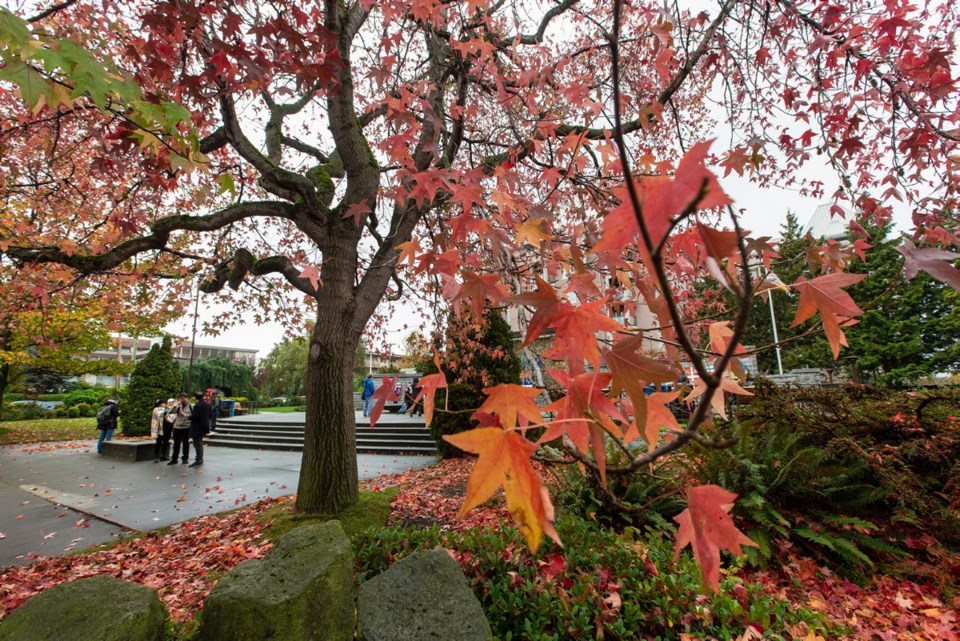Autumn is not typically the time of year when a person’s thoughts turn toward planting trees. As days shorten, leaves change colour and rain starts to fall, most city folk who think about trees are considering other tree-related thoughts.
They might be admiring the fall colours. They might be reaching for rakes and loppers. They might be cleaning up branches, leaves and needles, and attending to other maintenance of or because of trees.
The work can distract from backyard-forestry plans.
Not for Victoria Mayor Lisa Helps, however. Helps recently committed the City of Victoria to plant 5,000 trees by the end of 2020 as part of a global campaign launched by the United Nations.
The UN launched the Plant for the Planet campaign in the mid-2000s. The initial target was a mere one billion trees, but by 2009, the program had overtopped seven billion trees. It now is reaching for one trillion trees.
That puts the 5,000 Helps has promised into perspective. Spread over 10 years, her goal seems more reachable, working out to be less than two trees planted a day.
The issue is space. To address that, the city is counting on getting property owners on side.
That might be complicated.
It’s not that most people don’t like or appreciate trees.
Having trees around improves people’s physical and mental health. The more greenery around a residence, the less likely people living there will end up pushing up daisies prematurely due to natural causes.
Neighbourhoods with lots of greenery tend to be more cohesive social communities and experience less youth crime and domestic violence.
Urban forests attract birds, pollinators and other small critters, increasing local biodiversity and helping control mosquitoes, leaf-eating caterpillars and tree-boring beetles. Trees also reduce erosion, flooding, and air pollution, moderate city heat and pack away carbon.
But maintaining a mature urban forest can conflict with other values. The data bear this out. According to the Capital Regional District, the region’s core area lost 1,038 hectares of tree canopy between 1998 and 2011. Given housing pressures of recent years, the number likely has only increased. Ironically, Saanich — once reputed to worship trees — led the way, with 585 hectares of lost tree cover, beating out booming Langford (452 hectares) and Colwood (429 hectares).
As part of the push to fit more housing into the region, woodlands that line farm fields and cover neighbourhood greenspaces are being cut down to cash in and make room for new housing. Treed estates are being turned into townhouse estates. Lots are being subdivided to fit two or three new homes with footprints that extend to the maximum allowed limits, leaving enough “yard” for driveways, a row of petunias, and a shrub or two.
In older neighbourhoods, backyards that have harboured small orchards and gnarly oaks, elms or maples for decades are being bulldozed so that the older, modest-sized dwellings onsite can be replaced with huge, new houses with more bathrooms than residents.
All that development and densification leaves less land for urban forest.
And then there are those who don’t want to deal with the hazards large trees present. With storms increasing in frequency and severity, the risk of trees being blown down or having large branches break off onto vehicles and buildings has increased. Home insurance policies now ask about large trees growing near dwellings.
And others just don’t want the hassle. The leaf-clogged eavestroughs, root-blocked perimeter drains, cluttered gutters, the pruning and raking and all the other tree-related chores — many of which need to be done at this time of year.
But for those who do want more tree canopy in their lives, autumn is the best time of year to plant a tree. Fall temperatures are cool, with little risk that new plantings will face heat stress. Rainfall is regular, ensuring sufficient moisture for roots to become established. While above-ground tree parts become dormant in the fall, the roots of both evergreens and deciduous trees grow throughout the year, provided the ground temperature remains above 4 C.
For anyone looking ahead — to increased backyard birdsong next spring, more leafy patio shade next summer or further ahead to 2020 — this is the time of year to turn your thoughts toward that trillion-tree global target.



